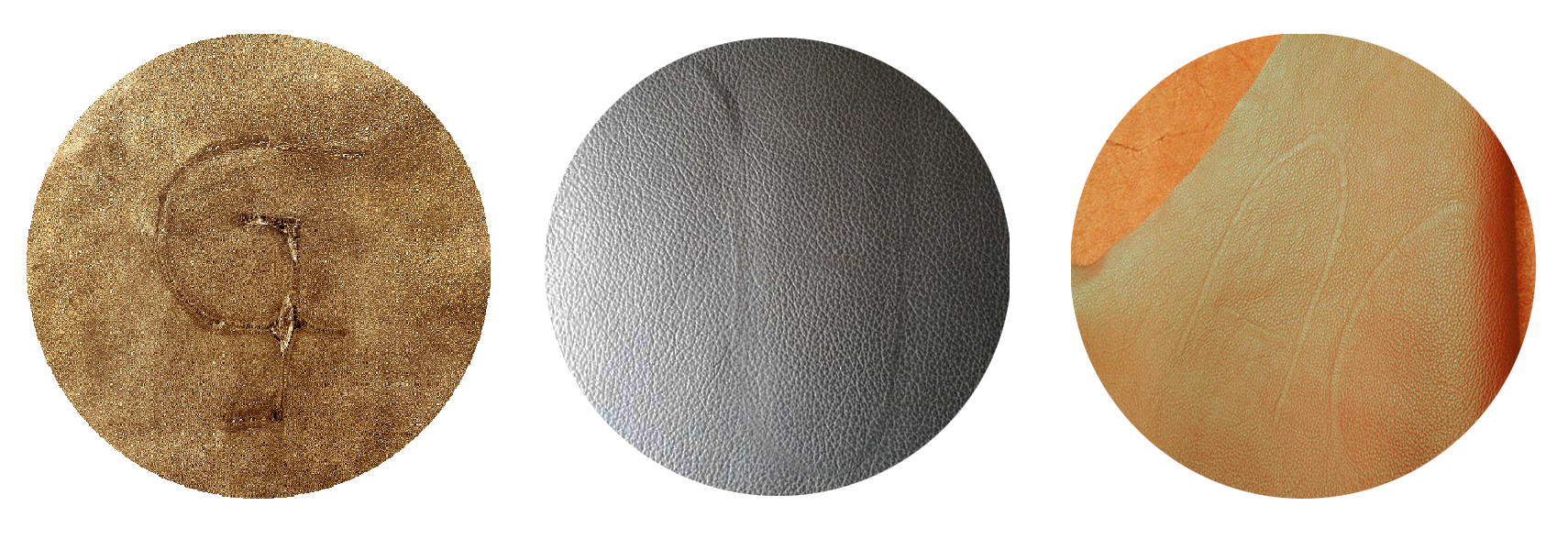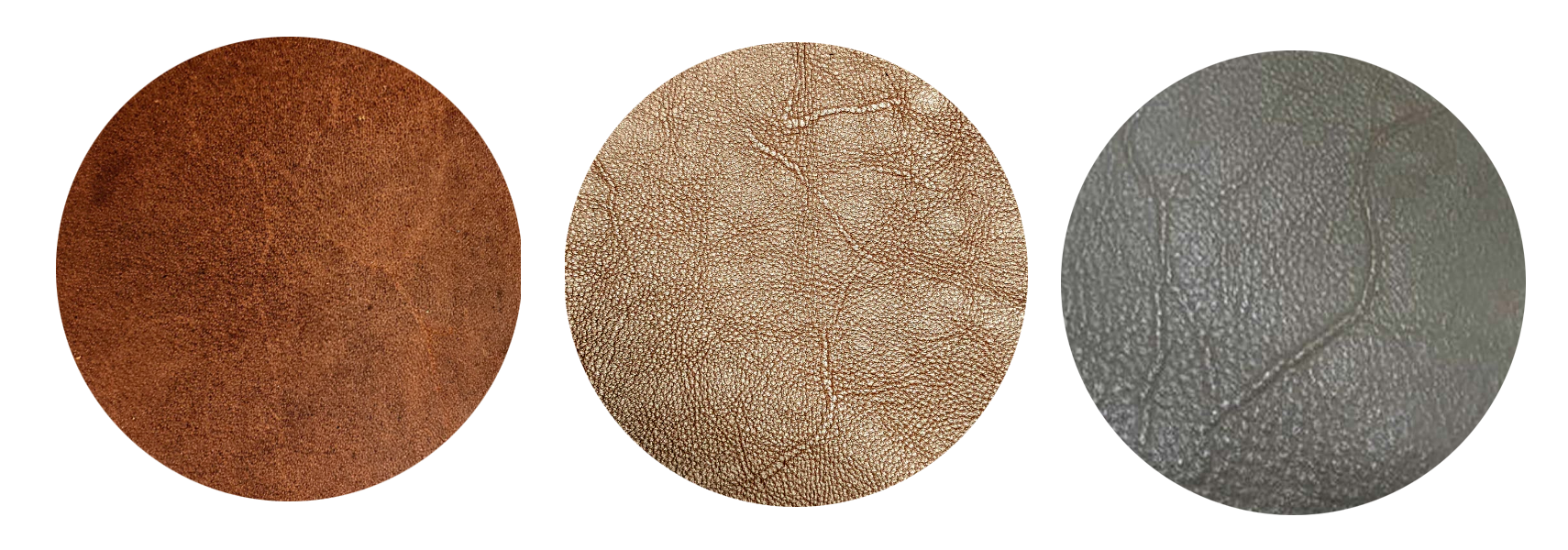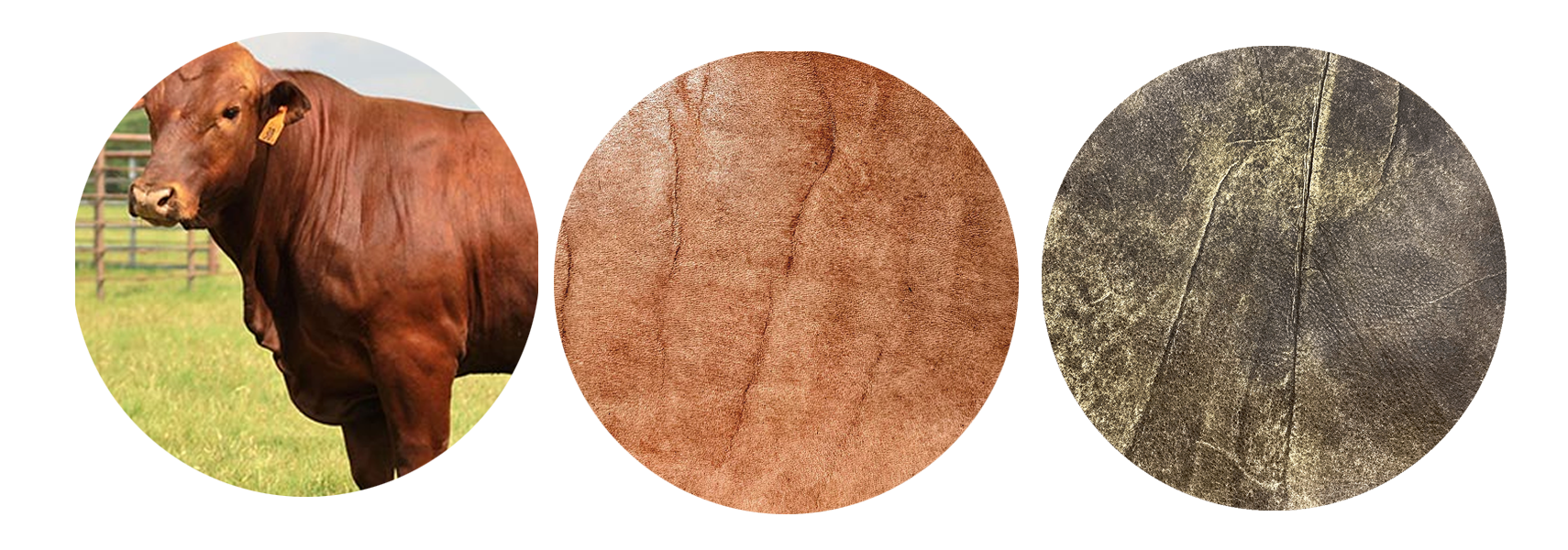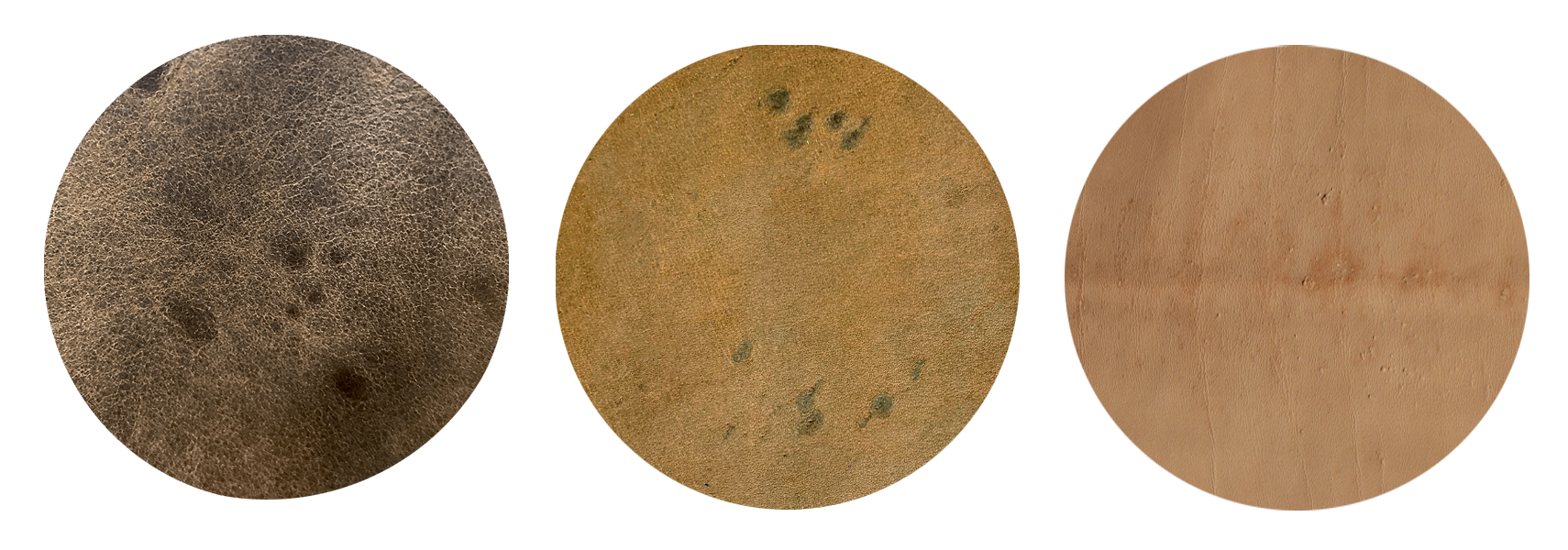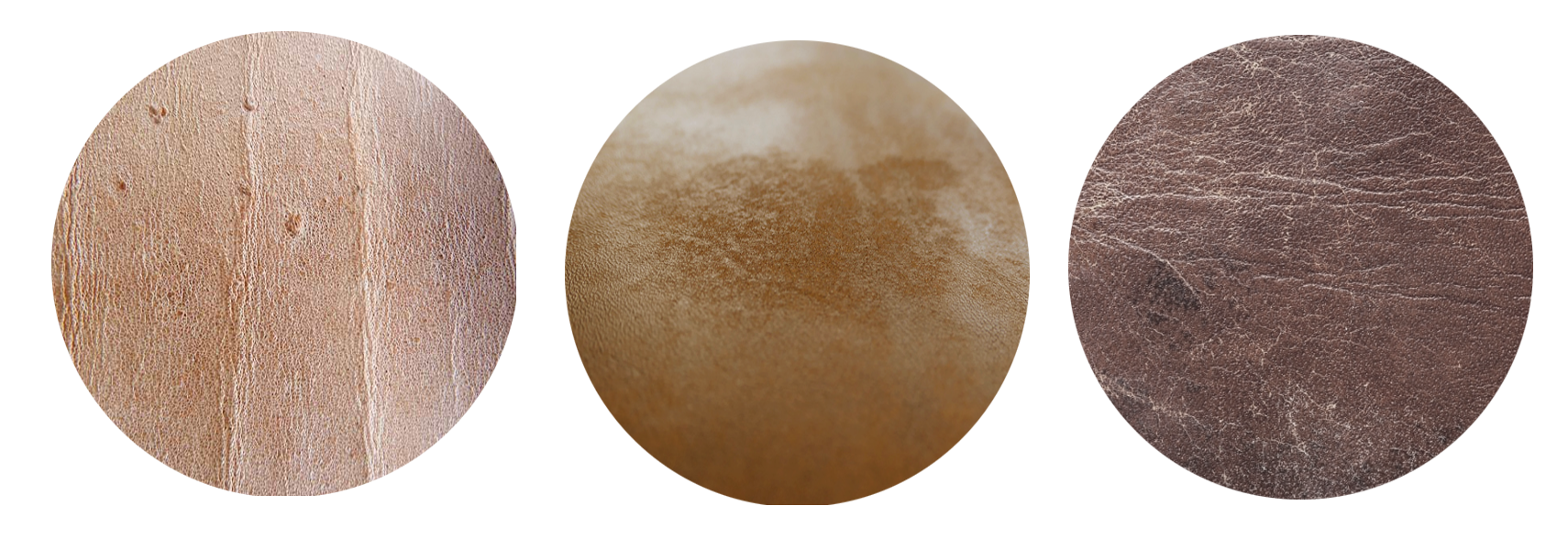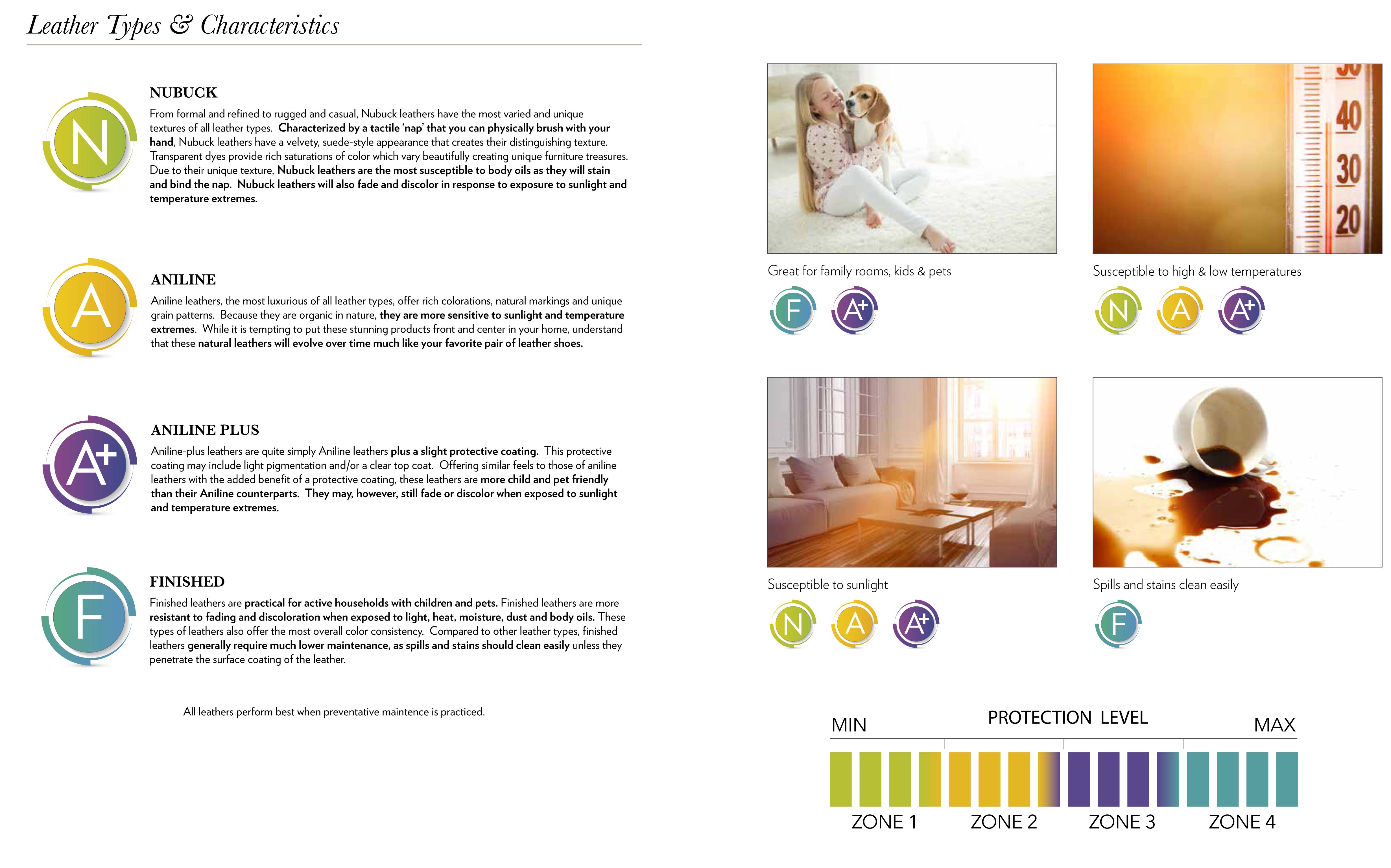
REAL LEATHER / LEATHER 101
SIGNS OF REAL LEATHER
Over time, a cow's hide, or surface grain, is subject to the varied markings of branding, veins, scars, wrinkles and bites. All are beautifully natural, authentic and integral to its hide. All are unique to leather and a sign that it's genuine. Look for any one or more of these natural markings on leather furniture. They only become apparent after the first processing stages in the tannery. Grading of leather is for pricing structure and unqiue to each manufacturer of leather furniture and not for quality grading. All hides are sorted by quality, the most expensive have the fewest imperfections. Hides with the fewest imperfectations receive less processing and are classified as a higer grade.
BRANDING MARKS
Found on virtually every hide, a brand mark varies from a letter or a number to a shape or image, and are usually one of the largest natural markings. If brand marks are smooth and add to the character of the leather, they will be placed on the sides or outside backs of leather furniture.
VEINS
A cow's blood vessels appear as irregular, marble-like veins on a hide. Usually more visible in the neck and across the backbone, veins are often more prominent in older cows, and can also reflect the cow's climate. In cold weather, veins contract to reduce heat loss through the skin. In warm weather, veins expand to increase it. You will find these in any position on leather furniture. Given that veins are closer to the underside of the cow's hide, they appear most commonly in split leathers.
SCRATCHES AND SCARS
While deep and unhealed scars are cut out of the hide, thin surface scratches are part of the natural characteristic of leather. Healed scars are as strong as the rest of the hide. Healed scratches and scars can appear in any position on leather furniture.
WRINKLES, STRETCH MARKS AND CREASES
As each hide takes on the characteristics of the cow it comes from, the natural belly stretches and markings will appear. These are generally located along the edges of the hide where the leather is loose, stretchy, and the surface has a 'bubbly' appearance. Wrinkles occur naturally wherever loose skin is located on the hide. They are typically found in the neck and shoulder, and can be common in belly areas. Wrinkles and stretch marks are typically placed on the sides and back of leather furniture. Mild creases may appear anywhere on the piece.
BITES AND PIN HOLES
Mosquitoes, ticks, flies and parasites all take their pound of cow flesh, leaving behind small circular marks or tiny holes on a cow's hide. Bites are a common occurrence on hides and leather furniture, but mostly innocuous and typically small. Bites and pin holes can appear anywhere on leather furniture.
Manure Burns
Manure or dung marks are caused from feces sticking to the skin for a prolong period of time If not removed quickly it can cause burns from the acids. These show more on Aniline leathers if mild, although they may appear on a finished leather but will be less prominent.
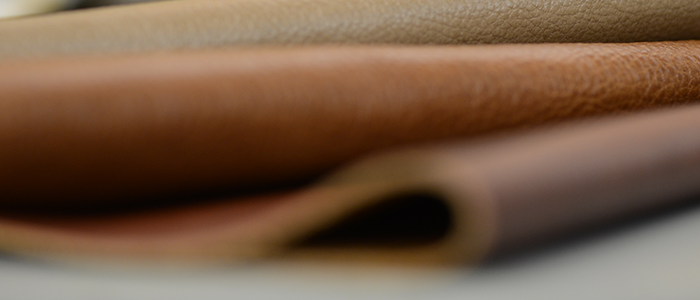
LEATHER GRAIN
IT'S ALL ABOUT THE GRAIN
Strong, supple, and in sync with our body temperature, top grain leather is always the top choice for leather furniture. But anyone shopping for leather furniture quickly learns that there's more to top grain leather than its location on the hide. A range of lifestyles and budgets have spawned many types of top grain leathers, or grades. The easiest way to navigate the market's many choices is to remember that leather's authenticity, price, performance, texture and even colour all come down to the question of grain. Is it natural, corrected, or somewhere in between?
Natural Full Leather Grain
The top of the top grain selection is uncorrected or natural, full grain leather. These premium hides are the real deal – fully authentic because they retain all the natural textures and markings of the cowhide, with no imperfections changed or corrected. Only five percent of all upholstery hides rank in this elite status. Full grain leathers are coloured with clear (aniline) or semi-clear (semi-aniline) dyes to highlight, rather than cover, their natural grain and markings. But with little or no opaque pigment in these dyes, each individual cell on the hide will absorb colour in its own way. Similar to the colour variation that occurs when a wood grain is stained, full grained leathers are fully unique, emphasizing leather's natural, one-of-a-kind quality.
Top Grain Corrected Grain
Most top grain leather is partly or fully corrected. These hides retain the quality, thickness, strength and supple feel of their top grain, but arrive at tanneries with too many unwanted blemishes. Some hides are gently buffed to even out the grain; others are sanded to remove unwanted markings and then embossed with a uniform grain pattern. Many levels of corrected leathers exist, from slightly to heavily altered, depending on the original condition of the hide. Partly corrected hides look and feel more natural than fully corrected hides. And like full grain leather, their more natural graining, which is often not uniform in appearance, can make them more costly. Partly corrected hides can be coloured with semi-clear (semi-aniline) dyes. But fully corrected hides are dyed with opaque pigments to help cover any unwanted natural marking. Split leather is always fully corrected and dyed with opaque pigments. As the bottom layer of a hide that's been spliced, split leathers lack the natural graining of top grain leather, so they benefit from grain embossing and solid colour pigments. Split leathers are usually applied to the outside arms and back of leather furniture as a complement to top grain leathers which are located on the seats, inside backs and arms basically everywhere your body touches. Leather correction doesn't affect leather's durability in any way. Though natural grains are altered for greater uniformity, corrected leathers are extremely durable and can be more suitable to active lifestyles than un-corrected, full grain leathers.

LEATHER CARE
PIGMENTED, SEMI – ANILINE LEATHERS
To keep your leather looking beautiful for a long time to come please follow these instructions:
Leather should be cleaned often. Frequent and gentle cleaning is easier on leather versus less frequent, more aggressive cleaning. Cleaning will remove dust, dirt, and perspiration. We recommend that you first wipe off any dust, paying special attention to those areas where particles will collect, such as the area between the seat and the cushions. Visit here for an Approved Leather cleaner/conditioner kit to maintain the leather.
Clean pigmented and semi-aniline leather should be cleaned with a mild soap and water solution (a mild soap will have a neutral pH so it is not harsh on your skin and therefore not harsh on the leather). For general cleaning, use a weak solution of soap; 3 – 4 drops of soap per liter of water. Use a slightly higher concentration to remove more excessive dirt. Always wipe off any residual soap solution from the leather with a clean, damp cloth. It is important that you do not saturate the leather. Always test the soap solution in an unseen area of the sofa to ensure the solution does not damage the leather.
Conditioning is not necessary unless subject to heat and sun. Cleaning to remove skin oils is the best prevention to any deterioration of the leather. The use of some conditioners or treatments on your furniture will void the manufacturer's warranty.
Some other important things to keep in mind:
- Special attention should be given when cleaning the areas where there is more skin contact with the leather.
- Hair products and skin oils will chemically attack the finish on the leather.
- Exposure to sun and/or extreme light sources will cause fading and potential damage.
- Dark jeans and other clothing have a high risk of dye transfer onto the leather, especially when the leather is lighter in colour.
- Sharp objects will easily puncture and cut into leather.
COVER CARE – NATURAL AND FULL ANILINE
Leather should be cleaned often. Frequent and gentle cleaning is easier on leather over less frequent, more aggressive cleaning. Cleaning will remove dust, dirt, and perspiration. We recommend that you first vacuum off any dust, paying special attention to those areas where particles will collect, such as the area between the seat and the cushions.Visit here for an Approved Leather cleaner/conditioner kit to maintain the leather.
Clean aniline leathers only using a slightly damp cloth and then immediately wipe with a dry cloth. Do not use any type of soap on aniline leathers. It is important that you do not saturate the leather.
Conditioning is not always necessary. Cleaning to remove skin oils is best prevention to any deterioration of the leather. The use of some conditioners or treatments on your furniture will void the manufacturer's warranty.
Some other important things to keep in mind:
- Special attention should be given when cleaning the areas where there is more skin contact with the leather
- Hair products and skin oils will chemically attack the finish on the leather.
- Exposure to sun and/or extreme light sources will cause fading and potential damage.
- Dark jeans and other clothing have a high risk of dye transfer onto the leather, especially when the leather is lighter in colour.
- Sharp objects will easily puncture and cut into leather.











